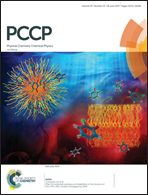Hierarchically structured composites for ultrafast liquid sensing and smart leak-plugging†
Abstract
Conductive polymer composites (CPCs) have been intensively exploited as remarkable liquid sensing materials based on variations in their conductivity under liquid stimuli. However, most advances in liquid sensing CPCs are limited to bulk materials. Due to the slow permeation of liquids into the compact CPCs, sluggish responses are inevitable for most existing CPC-based liquid sensing materials. Here, we developed a new class of liquid sensing materials via a hierarchical structure design. Specifically, a thin CPC layer with a segregated conductive network was coated on porous polyurethane (PU) skeletons by layer-by-layer assembly, forming an elaborately designed hierarchical structure in the prepared CPC@PU composites. With this hierarchical structure, the CPC@PU composites exhibited ultrafast responses (0.05–0.15 s) to solvent stimuli, which are ∼3 orders of magnitude faster than the state-of-the-art composites. After liquid sensing, quick regeneration (within 10 s) could be achieved under hot-air. Accordingly, organic liquid and gas sensors and liquid-sensing electronic skins were fabricated. Furthermore, we prepared smart and fast leak-plugging materials using the CPC@PU composites based on the swelling-induced blocking of micropores in the materials. This structural strategy proposed here opens up exciting avenues towards manufacturing real-time liquid sensing and plugging materials, revealing potential applications in oilfield exploitation, solvent storage/transportation, environmental monitoring, etc.



 Please wait while we load your content...
Please wait while we load your content...